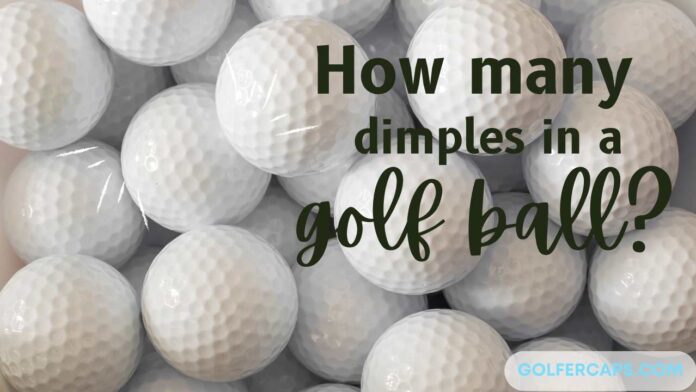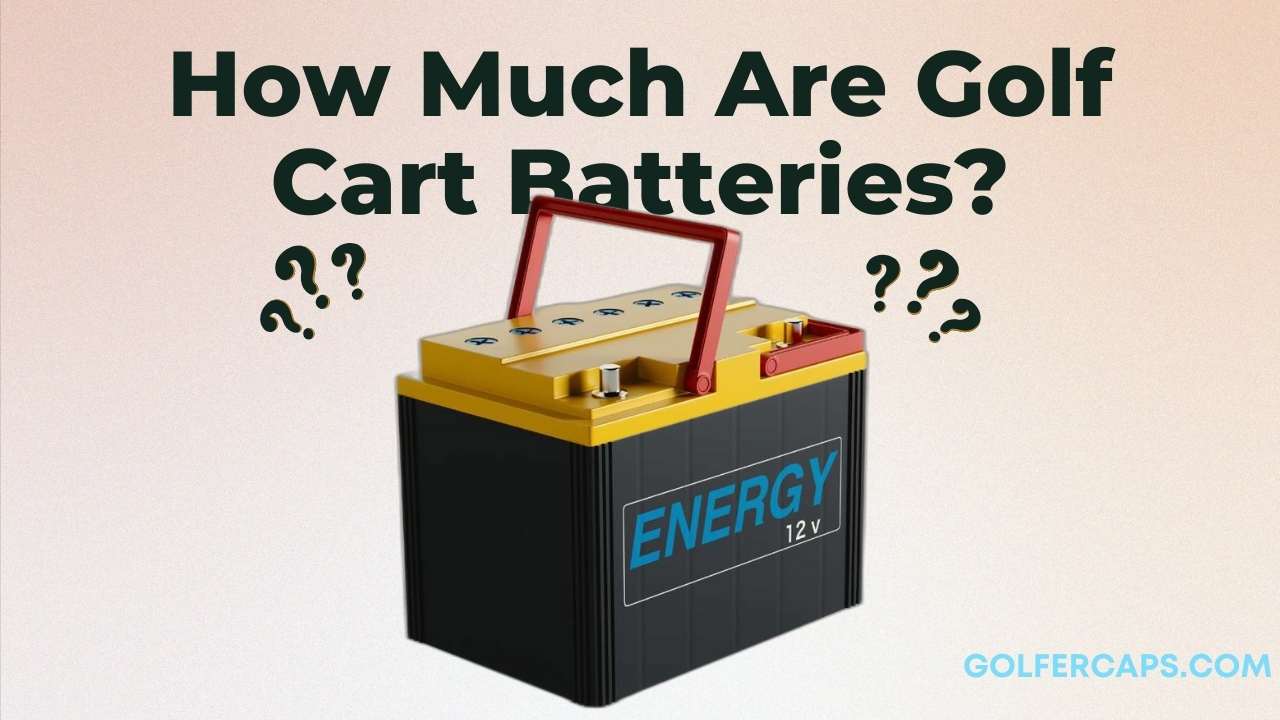Have you ever wondered what gives a golf ball its unique flight characteristics? One of the unsung heroes of the golfing world is the humble dimple. These small indentations on the surface of a golf ball play a crucial role in its aerodynamics, affecting everything from distance to accuracy. Let’s delve into the fascinating world of golf ball dimples and uncover their secrets.
we will explore:
- How many dimples in a golf ball?
- How many dimples are on a pro v1 golf ball?
- Are more dimples on a golf ball better?
- The Science Behind Dimples
Table of Contents
ToggleHow many dimples in a golf ball?
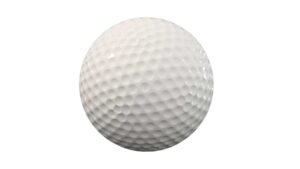
The number of dimples on a golf ball can vary depending on the manufacturer and model, but typically there are between 300 and 500 dimples on a golf ball. The exact number isn’t as important as the overall dimple pattern, which plays a role in how the ball flies through the air.
Read also: How many golf clubs in a set?
How many dimples are on a pro v1 golf ball?
There are 388 dimples on a Titleist Pro V1 golf ball. The dimple pattern is a spherically-tiled tetrahedral design, which is optimized for aerodynamics to fly consistently and far.
most dimples on a golf ball

There isn’t a single, definitive answer to which golf ball has the most dimples. Manufacturers constantly experiment with dimple patterns and count, and the number can vary between different models from the same brand. However, most golf balls tend to fall within a range of 300 to 500 dimples, with some outliers on either end.
The focus for manufacturers isn’t necessarily maximizing the number of dimples, but rather designing the optimal pattern for flight and performance.
Are more dimples on a golf ball better?
No, more dimples on a golf ball aren’t necessarily better. The key factor is the overall dimple pattern and design, not just the quantity.
Here’s why:
- Aerodynamics: Dimples help a golf ball fly farther and straighter by reducing drag. The dimple pattern creates a thin layer of air around the ball, which helps it stay aloft and travel efficiently.
- Optimal Design: There’s a sweet spot for dimple design. Too many dimples could disrupt the airflow and negatively affect performance.
Manufacturers spend a lot of time researching and developing the optimal dimple pattern for their golf balls. This involves factors like:
- Dimple depth
- Dimple shape
- Dimple distribution
These factors work together to create the ideal aerodynamic effect for a particular ball’s performance goals.
Read also: How Much Are Golf Cart Batteries?
why are there dimples on a golf ball?
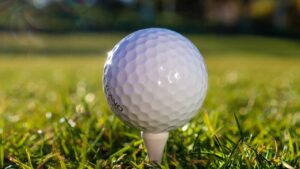
Dimples on a golf ball play a crucial role in its flight by influencing aerodynamics. Here’s the breakdown:
- Drag Reduction: Imagine a smooth golf ball soaring through the air. It would experience significant drag, a force that slows it down. Dimples act like tiny dimples on an airplane wing, disrupting the smooth airflow around the ball.
- Lift Generation: By disrupting the airflow, dimples create a thin layer of air that clings to the ball’s surface. This layer, called a boundary layer, helps the ball stay aloft for longer and travel farther.
- Stability: Dimples also contribute to a golf ball’s stability in flight. The specific dimple pattern helps the ball spin consistently, which keeps it on a predictable trajectory.
In essence, dimples are like the secret sauce for a golf ball’s flight. They help it overcome air resistance, stay aloft, and travel a greater distance with more control.
History of Golf Ball Dimples
The evolution of golf ball dimples is a fascinating journey that spans centuries. From smooth, wooden spheres to the high-tech, dimpled orbs we use today, the story of dimples is intertwined with the history of golf itself.
1. Early Golf Balls:
In the earliest days of golf, dating back to the 15th century, players used wooden balls made from hardwoods like beech or boxwood. These balls were completely smooth, lacking the dimples we associate with modern golf balls. While effective for the time, these smooth balls had limited flight characteristics and were prone to scuffing and damage during play.
2. The Discovery of Dimples:
The first recorded use of dimples on a golf ball dates back to the mid-19th century. Golfers noticed that older, scuffed balls tended to fly farther and straighter than new, smooth ones. This observation led to experimentation, and eventually, the discovery that indentations on the surface of a golf ball could significantly improve its flight.
3. Early Dimple Designs:
The earliest dimpled golf balls featured rudimentary designs, with irregular patterns and sizes. Golf ball makers experimented with different dimple arrangements, often using hand tools to create the indentations. These early dimple patterns varied widely and lacked the uniformity seen in modern golf balls.
4. Refinement and Innovation:
As golf gained popularity and technology advanced, manufacturers began to refine and innovate dimple designs. Researchers studied the aerodynamics of golf balls, seeking to understand how dimples affected flight characteristics. This research led to the development of more sophisticated dimple patterns and configurations, aimed at maximizing distance, accuracy, and control.
5. Evolution of Dimple Patterns:
Over time, dimple patterns evolved from simple, irregular arrangements to complex, geometric designs. Today, golf balls feature a wide range of dimple patterns, including symmetrical and asymmetrical layouts, as well as combinations of different dimple shapes and sizes. Each dimple pattern is carefully engineered to optimize aerodynamic performance for different swing speeds, conditions, and playing styles.
6. Regulation and Standardization:
As golf ball technology advanced, governing bodies like the United States Golf Association (USGA) and the R&A (golf’s rule-making authority) introduced regulations to ensure fair play and maintain the integrity of the game. These regulations govern aspects of golf ball design, including size, weight, and initial velocity, but do not specifically dictate dimple patterns or configurations.
7. Continued Innovation:
Even today, manufacturers continue to innovate and refine dimple designs in pursuit of better performance. Advanced computer modeling and simulation tools allow designers to optimize dimple patterns with unprecedented precision, pushing the boundaries of what’s possible in terms of distance, accuracy, and control.
Read also: HOW MUCH ARE GOLF CARTS?
The Science Behind Dimples
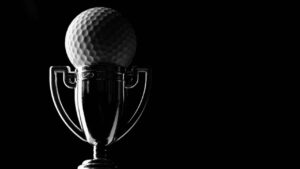
Dimples on a golf ball may appear simple, but their impact on performance is anything but. Let’s delve into the fascinating science behind these small indentations and how they affect the flight of a golf ball.
1. Understanding Airflow:
When a golf ball is struck, it moves through the air, creating a layer of turbulent air around itself called the boundary layer. This layer of air can create drag, slowing down the ball and reducing its distance.
2. Role of Dimples:
Dimples on the surface of a golf ball disrupt the airflow, reducing the size of the wake behind the ball. This, in turn, decreases the drag force acting on the ball, allowing it to travel farther with less effort.
3. Increasing Lift:
Dimples also play a crucial role in increasing lift. By causing the airflow to cling to the surface of the ball for a longer period, they create an upward force that helps keep the ball airborne. This lift not only contributes to greater distance but also helps the ball maintain a more stable trajectory.
4. Impact of Dimple Depth and Pattern:
The depth and pattern of dimples on a golf ball can significantly impact its aerodynamic properties. Deeper dimples may create more turbulence, leading to greater drag reduction, while different dimple patterns can affect how air flows over the surface of the ball.
5. Optimizing Performance:
Manufacturers carefully design dimple patterns and configurations to optimize performance for different swing speeds, conditions, and playing styles. By experimenting with various dimple depths, sizes, and arrangements, they aim to create golf balls that maximize distance, accuracy, and control.
6. Beyond Golf:
While dimples are most commonly associated with golf balls, similar principles apply to other sports equipment and vehicles. From tennis balls to race cars, dimples and other surface textures are used to manipulate airflow and enhance performance.
How does Dimple Count affect performance?
The number of dimples on a golf ball can significantly influence its performance on the course. Let’s explore how dimple count impacts various aspects of a golf ball’s flight and overall playability.
1. Aerodynamics:
Dimple count directly affects the aerodynamics of a golf ball. Generally, a higher dimple count results in better aerodynamic performance. More dimples create more turbulent airflow around the ball, reducing drag and allowing it to travel farther through the air.
2. Distance:
In general, golf balls with a higher dimple count tend to fly farther than those with fewer dimples. This is because the reduced drag generated by a greater number of dimples allows the ball to maintain its speed over a longer distance. Players looking to maximize distance off the tee often opt for golf balls with a higher dimple count.
3. Trajectory:
Dimple count can also influence the trajectory of a golf ball. Balls with a higher dimple count tend to have a more penetrating flight path, which can result in greater carry distance and better control in windy conditions. Conversely, balls with fewer dimples may produce a higher trajectory, which can be advantageous for approach shots into the green.
4. Spin Control:
The dimple count can impact spin control, particularly on short-game shots. Golf balls with a higher dimple count may provide more spin around the greens, allowing players to impart more backspin or sidespin on the ball for increased control and stopping power on the putting surface.
5. Feel and Sound:
While not directly related to performance, the dimple count can also affect the feel and sound of a golf ball. Balls with a higher dimple count may feel softer off the clubface and produce a different sound upon impact compared to balls with fewer dimples. This can influence a player’s perception of the ball and may impact their confidence and overall enjoyment of the game.
6. Personal Preference:
Ultimately, the ideal dimple count is subjective and depends on the individual preferences and playing style of each golfer. Some players may prefer the feel and performance characteristics of golf balls with a higher dimple count, while others may prefer the feel of balls with fewer dimples. Experimentation and testing different ball models can help golfers determine which dimple count best suits their game.
Measuring Dimple Count
Counting the number of dimples on a golf ball may seem like a straightforward task, but it’s quite challenging. Dimples come in various shapes and sizes, and their arrangement can be complex. Manufacturers typically use specialized equipment to ensure accurate counts, as even a single dimple can make a difference in performance.
Despite efforts to standardize dimple counts, there’s still variability among different golf ball brands and models. Some balls may have symmetrical patterns, while others feature irregular designs that make counting difficult. However, regardless of the dimple count, the principles of aerodynamics remain the same.
Conclusion
Next time you tee up a golf ball, take a moment to appreciate the intricate dimple pattern on its surface. These tiny features may seem insignificant, but they are crucial in determining the ball’s flight path and overall performance. By understanding the science behind dimples, you can make more informed decisions about which golf ball is best suited to your game.
FAQs:
1. What is the typical range of dimple count in golf balls? The typical dimple count in golf balls ranges from around 300 to over 500, though there can be variations both within and outside this range depending on the manufacturer and ball model.
2. Do all golf balls have the same dimple count? No, different golf balls have different dimple counts, as manufacturers tailor the dimple design to optimize performance for specific playing conditions and golfer preferences.
3. Can you visually distinguish between different dimple patterns? Yes, dimple patterns can vary significantly between different golf ball models. Some have symmetrical patterns, while others feature irregular arrangements that may be visually distinctive.
4. How do manufacturers determine the optimal dimple count for a golf ball? Manufacturers use extensive testing and research to determine the optimal dimple count for a golf ball, considering factors such as aerodynamics, ball speed, spin, and control.
5. Are there any regulations regarding dimple count in golf balls? While there are no specific regulations dictating dimple count in golf balls, governing bodies like the USGA and R&A have guidelines to ensure that balls meet certain performance standards.

